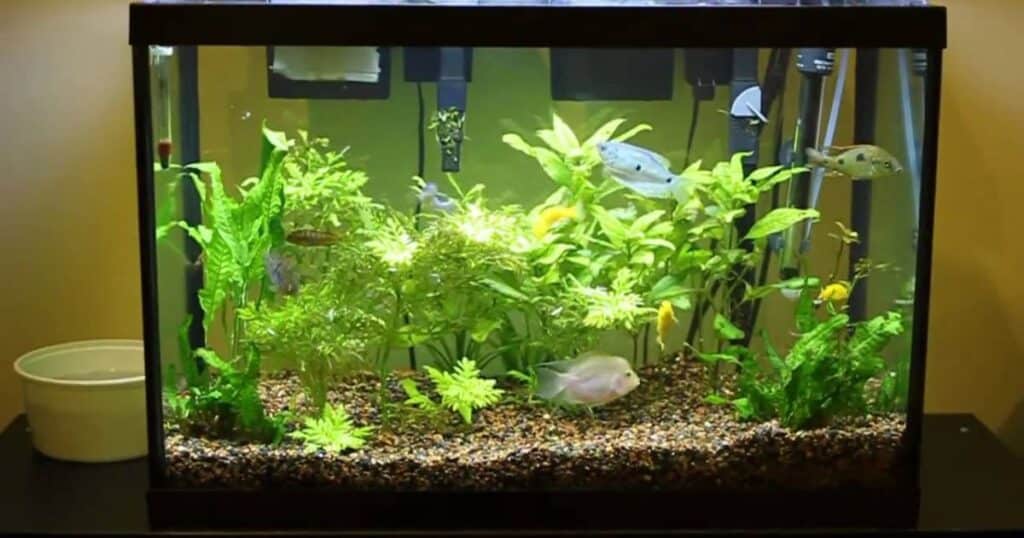Are you looking to set up a tiny slice of aquatic life right in your home or office? A 2.5 gallon nano tank can be the perfect solution, allowing you to experience the joy and fascination of fishkeeping even with limited space. However, choosing suitable species for such a compact aquarium is crucial.
In this comprehensive guide, we’ll explore ten amazing fish options along with essential tips for successfully stocking and maintaining your mini underwater world.
Key Takeaways
- Small tanks like 2.5 gallons require extra care in fish selection to ensure proper sizing, compatibility, and manageable bio-load.
- Top nano fish picks include tetras, barbs, rasboras, minnows, loaches, guppies, danios, corydoras, killifish, and livebearers.
- Non-fish species like snails, shrimp, and African dwarf frogs can add fun activity and functional benefits.
- Factors like tank size, experience level, stocking strategies, and maintenance practices are vital for success.
- With smart planning, these petite aquariums can thrive as captivating desktop eco-systems.
Choosing the Best Fish for 2.5 Gallon Tanks
While the idea of a tiny fish tank might seem simple, there are several crucial factors to consider when stocking a 2.5 gallon nano aquarium. Overlooking these can quickly lead to disaster, so let’s review the key elements.
Things to Consider (size, compatibility, filtration)
- Size: It’s essential to select fish species that will remain suitably small as adults. Overcrowding in such a compact space can rapidly degrade water quality and stunt growth. As a general rule, no individual fish should exceed 2 inches fully grown.
- Compatibility: Even in a small community tank, you’ll need to ensure your fish species get along harmoniously. Avoid overtly aggressive or territorial species that may bully tankmates. Peaceful schooling varieties tend to fare best.
- Filtration: Tiny tanks have virtually no margin for error regarding water quality. An efficient yet low-flow nano filter or sponge filter is crucial for maintaining stable parameters. Don’t underestimate the filtration needs for such high bioloads.
By carefully weighing size, temperament, and waste output factors, you can create a healthy, thriving microhabitat. With some basic care and smart stocking, these miniature ecosystems can beautifully showcase the underwater world’s wonders.
Ten Amazing Fish for Your 2.5 Gallon Tank
Now that we’ve covered the essential considerations, let’s dive into some top-notch fish picks well-suited for 2.5 gallon freshwater nano tanks.
Bloodfin Tetras
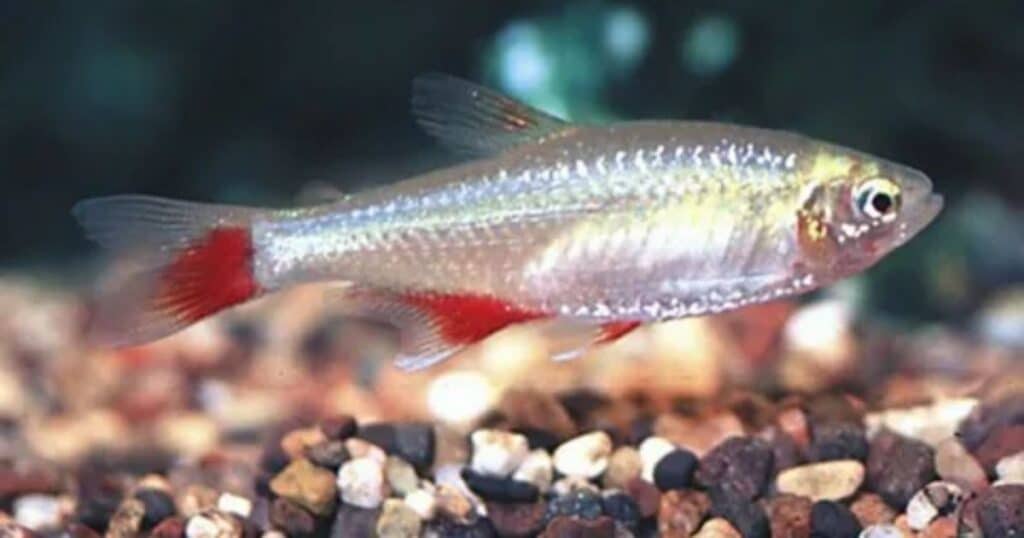
Max Size: Around 1 inch
Recommended School Size: 6-8
If you’re seeking a vibrant, energetic centerpiece for your nano aquarium, look no further than the bloodfin tetra (Aphyocharax anisitsi). Despite their diminutive size, these lively characters pack a serious punch of color with their glowing red fins and iridescent silver bodies.
Bloodfins do best when kept in a school of 6 or more individuals, where you can fully appreciate their tight-knit shoaling behaviors. Their peaceful community nature allows them to coexist with most tiny, non-aggressive tankmates.
“Within the aquarium hobby, the bloodfin tetra is quite possibly the smallest and best nano fish currently available in the trade.”
Aqua Utilities
These zippy fish remain in constant motion, delighting observers with their frenetic dances through tightly planted nano tanks. Just be sure to stick to a quality flake or micropellet diet to meet their big appetites.
Small Barb Fish
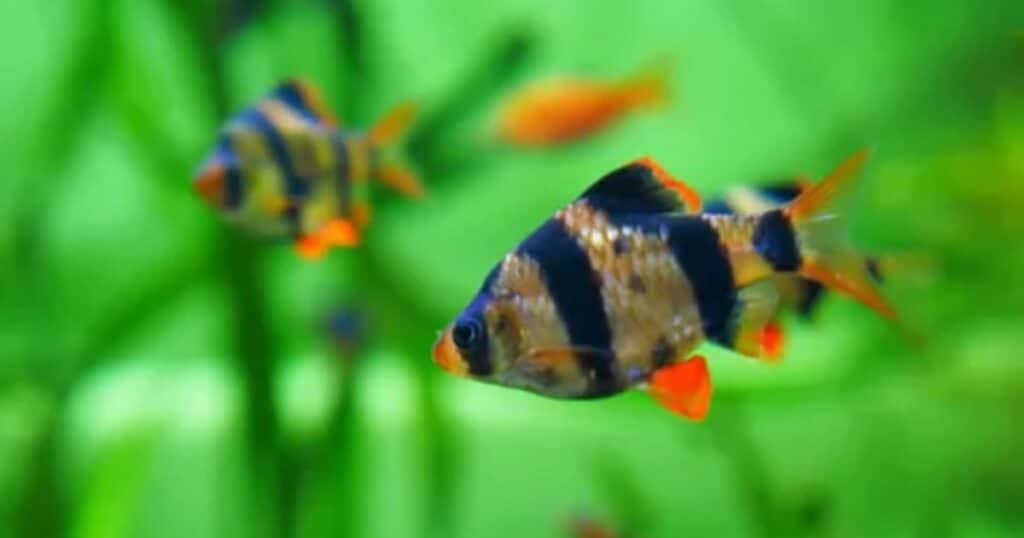
Max Size: 1-2 inches
While the popular tiger barb sadly outgrows most nano aquariums, there are some fantastic micro barb varieties perfectly suited for 2.5 gallon tanks. Two top-notch options include:
- Cherry Barb (Puntius titteya)
- Brilliant red coloration with black striping
- Peaceful in schools of 6+, may nip fish with long fins
- Accepts wide range of foods, but protein is key
- Odessa Barb (Puntius padamya)
- Attractive purple hue over golden body
- Very hardy and peaceful community fish
- Do best in schools of 6+
Like most barb species, these nano varieties absolutely must be kept in groups to avoid stress and rowdy behaviors. Provide plenty of thick planting, driftwood nooks, and hiding spots to make them feel secure.
Rasboras
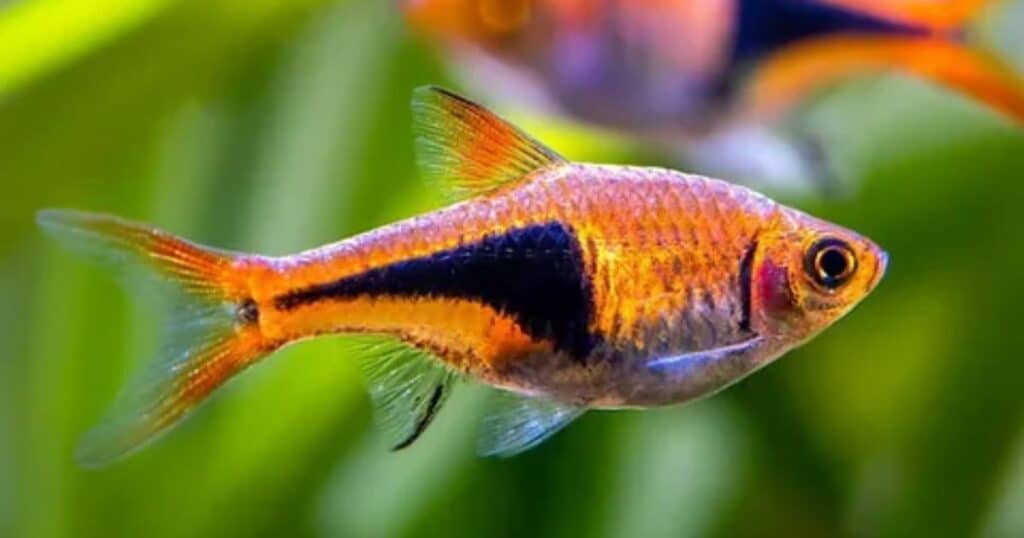
The rasbora clan contains some of the most perfect pint-sized fish for cramped quarters like 2.5 gallon tanks. Here are two stellar species well worth consideration:
- Chili Rasbora (Boraras brigittae): Maxing out around an inch long, these adorable fish pack a spicy punch of orange, red, and black hues. Very peaceful in schools.
- Celestial Pearl Danio (Celestichthys margaritatus): With their glittering gold and sky blue colors, these eye-catching 1-inch nano fish are aptly named. Do best in schools of 8+.
Most rasbora species thrive when kept in tightly-knit schools of 6 or more individuals over a densely planted environment. Like most nano fish, they’re inexpensive, low-waste, extremely active little characters that inject lively splashes of color and movement.
Minnows
When it comes to nano tanks, you can never go wrong with hardy minnows! From the classic rosy red (Pimephales promelas) to the vibrant tarnished minnow (Pimephales notatus), the vast minnow clan is bursting with compact options.
These unfussy, schooling fish:
- Stay very small (usually under 2 inches)
- Are extremely low-waste and low-maintenance
- Breed readily, so overfeeding must be avoided
- Lend lively movement and shimmery good looks
- Do best kept in groups of 6 or more
Minnows make a great dither fish choice to calm rambunctious or skittish tankmates. Their tight shoaling instincts and ultra-tiny bioloads allow them to thrive in even the humblest of nano tanks.
Kuhli Loach
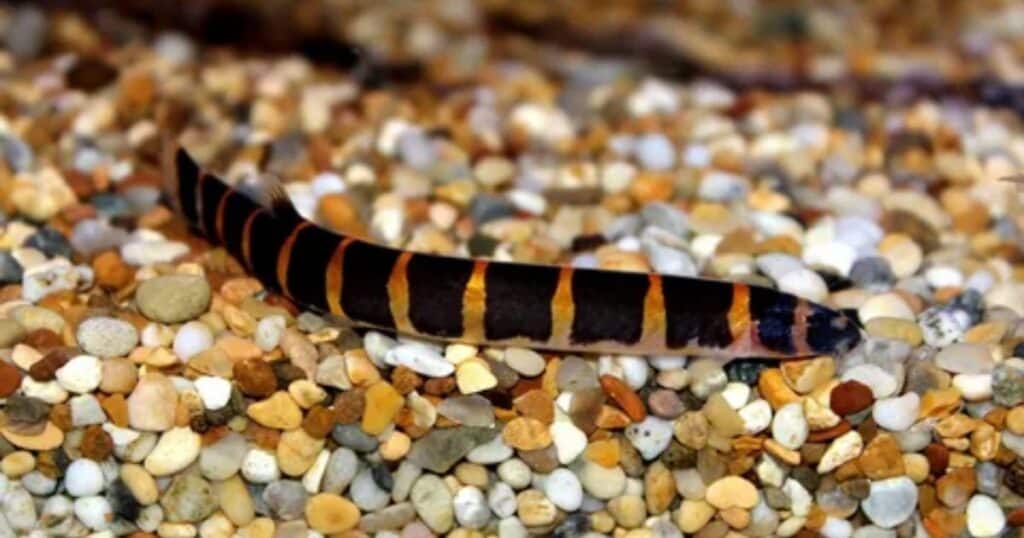
For anyone seeking a bit more flair and activity, the kuhli loach (Pangio kuhlii) is a seriously underrated micro species. Sure, at 3-4 inches, they’re a bit larger than our other picks—but these entertaining bottom-dwellers possess tons of personality packed into a compact, eel-like package.
Some fun facts about kuhli loaches:
- Very peaceful community fish that get along with most tankmates
- Endlessly amusing burrowing, hiding, and zig-zagging behaviors
- Do best in small groups of 3 or more over a soft sand substrate
- Excellent microorganism grazers, helping keep surfaces clean
Just be sure to provide ample rocks, driftwood caves, and vegetation for their reclusive natures. Kuhlis are nocturnal, so aquascaping with shaded nooks can encourage more outgoing daytime activity.
Guppies
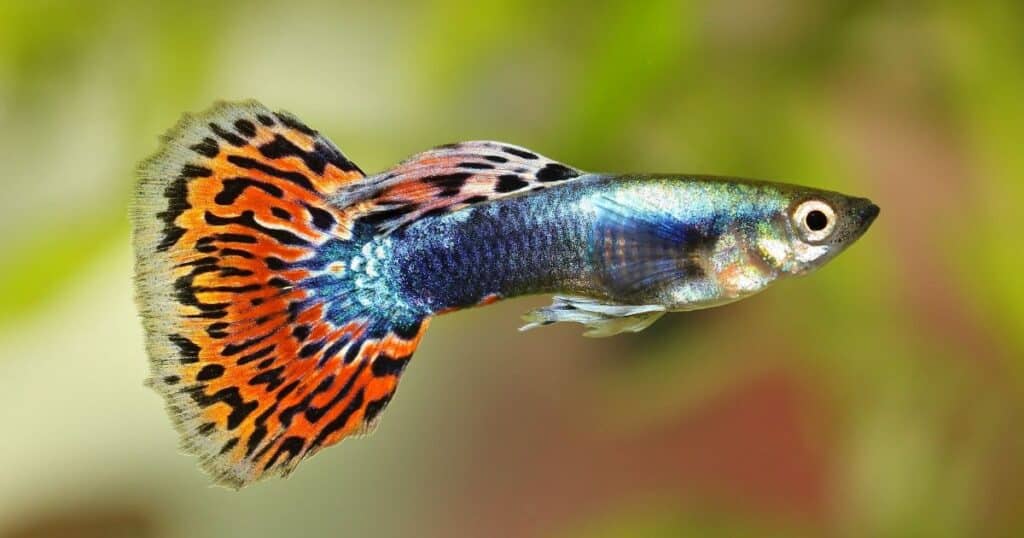
If you’re new to the freshwater fishkeeping scene, you’ve likely encountered the ever-popular guppy (Poecilia reticulata). These flashy livebearers have been captivating aquarists for decades with their vibrant arrays of colors, patterns, and flowing fins.
Pros of Nano Guppies:
- Stay relatively small (males around 1-2 inches, females slightly larger)
- Easy to care for, very hardy and undemanding
- Endless vivid color varieties to suit any taste
- Peaceful community fish when not overcrowded
- Females give birth to live fry regularly if you enjoy breeding projects
One important consideration is their prolific breeding potential. In compact quarters, care must be taken to avoid population booms that quickly foul water quality. Stick to stocking just a few guppies, and be sure to include plenty of vegetation for fry to seek refuge.
Danios
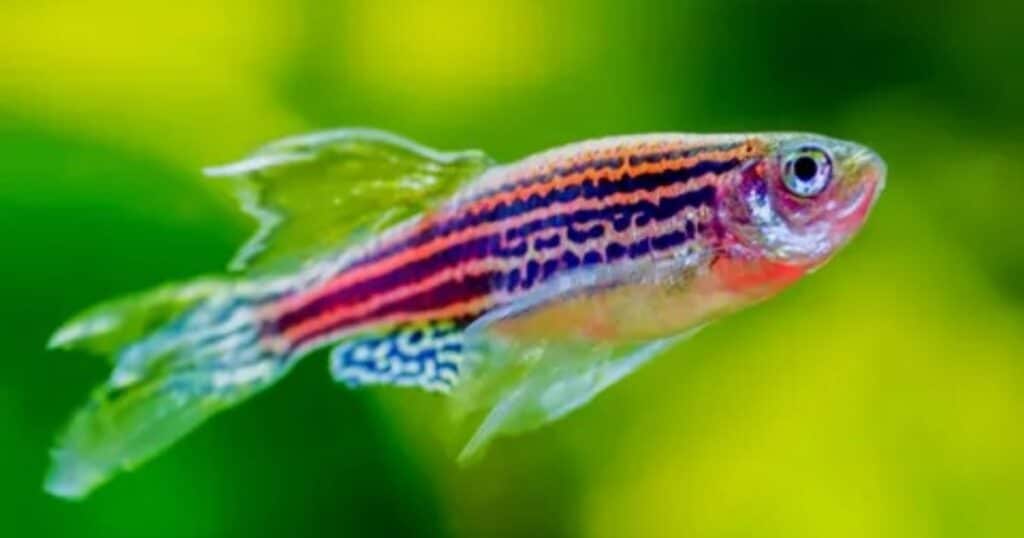
While the iconic zebra danio sadly requires more breathing room, its compact cousins like the glowlight danio (Danio choprai) and galaxy rasbora (Celestichthys margaritatus) can make excellent centerpiece fish for 2.5 gallons.
- Size: 1-2 inches max
- Peaceful schooling fish
- Vibrant coloration (yellow/orange bodies with bright blue striping)
- Very active swimmers that add movement
- Do best in schools of 6-8 individuals
These lively nano danio species share the classic elongated torpedo shape of their larger kin but in a much more compact, quarter-friendly size. Their constant swimming, shimmery colors, and tight shoaling behaviors create dazzling underwater displays.
To bring out their boldest personalities, set up a well-planted tank with open swimming areas. Danios appreciate an established matured aquarium, so start cycling your tank well before adding any fish.
Salt and Pepper Corydoras
Who can resist the comical faces and energetic wiggles of a corydoras catfish? The dwarf salt and pepper cory (Corydoras habrosus) allows you to enjoy all that adorable charm in a delightfully nano-sized, 1-inch package.
Some winning traits of this micro cory:
- Very peaceful schooling fish ideal for community setups
- Neat little scavenging behaviors as they hoover up untouched morsels
- Prefer soft sand substrates to shuffle/sift through
- Easy to satisfy with good sinking pellets or small live/frozen foods
- Do best kept in schools of 6 or more individuals
With their miniature size and low-waste bioloads, these plucky bottom-dwellers are the perfect scavenging crew for 2.5 gallon aquariums. Just avoid mixing with large, aggressive tankmates that may bully them.
Killifish
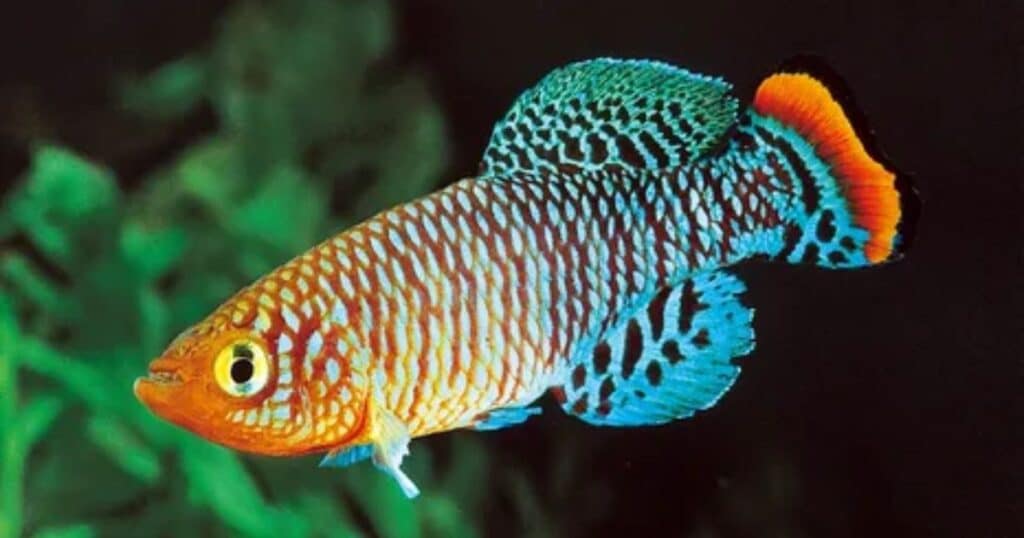
From the rainbow lyretail killifish to the tiny clown killifish, these lively micropredators inject tons of color and character into planted nano tanks. Most killifish varieties top out well under 2 inches, making them ideal candidates for compact aquascapes.
Some highlights of the captivating killifish clan:
- Often boast incredibly vibrant hues and bold patterns
- Very active, constantly patrolling swimmers
- Generally peaceful in community settings without much plant munching
- Longer lifespans compared to many nano fish (3-5 years)
- Interesting surface skimming and egg-laying behaviors to observe
With their dazzling looks and predatory hunting instincts, a school or pair of killifish can make for riveting focal points. Just take care not to overcrowd their territory, and provide plenty of dense planting.
Endler’s Livebearers
For fans of the iconic guppy species, their spunky little cousins—Endler’s livebearers—offer all the same vivid hues and peacefulness in a perfect nano-fish size package. Both the N-class Endler (Poecilia wingei) and Endler’s livebearer (Poecilia wingei) max out around a single inch long.
Some top advantages of Endler’s livebearers:
- Stay very tiny compared to standard guppies
- Every bit as brilliantly colored as fancy guppies
- Very prolific live-bearers…but less excessive than guppies
- Excellent community nano fish when not overstocked
- Unfussy omnivore diets of high-quality flakes and micro foods
While their smaller stature and slightly less prolific breeding make Endlers easier to manage than guppies, care must still be taken to avoid accidental population explosions. Stick to stocking just a few individuals and enjoy their flashy, entertaining schooling displays.
Non-Fish Species Suitable for a 2.5-Gallon Tank
While this guide focuses primarily on great fish picks, there are some equally awesome non-fish options that can add functional and behavioral flair to 2.5 gallon freshwater nano tanks:
Zebra Snails
Size: ~1 inch
Algae slowly but surely becoming an eyesore in your nano tank? Zebra nerite snails can be a perfect clean-up crew! A few key advantages:
- Excellent algae grazers on all surfaces
- Stay small and can’t reproduce in freshwater setups
- Peaceful and won’t harm live plants
- Endearing caddisfly larvae hitchhikers often tag along
Just avoid mixing with aggressive fish species that may pick on these peaceful little bioload janitors.
Cherry Shrimp
Size: 1-2 inches
For a vibrant splash of color contrast and fun scurrying activity, dwarf shrimp like cherry shrimp (Neocaridina davidi) or Amano shrimp (Caridina multidentata) can be amazing additions to nano tanks.
Not only do shrimp:
- Add tons of lively movement and personality
- Consume algae, detritus, and leftover foods
- Breed quite readily if you enjoy cultivating a colony
They also do an incredible job of luring your eyes into every nook and planted cranny of smaller aquascapes with their vibrant reds and blues.
Just avoid housing these shrimpies with overtly aggressive, large fish that may view them as bite-sized snacks!
African Dwarf Frog
While cold-blooded amphibians aren’t everyone’s cup of tea, the tiny African dwarf frog (Hymenochirus sp.) can make a delightful nano centerpiece species. At only 2-3 inches long, these fully-aquatic froglets maximize cuteness in a miniature package.
Some tips for successful frog-keeping:
- House singly or in pairs max, they’ll fight in groups
- Provide lots of hiding spots, horizontal resting spots
- Feed quality sinking pellets and small live/frozen foods
- Use a tighter-fitting lid to keep them from escaping
- Consider them the focal species, mixing with very shy fish only
With their wide dinner-plate mouths and personalities to match, African dwarf frogs make for infinitely amusing nano tank inhabitants. Just take care not to overfeed or allow water quality to suffer.
Stocking Ideas and Tips for Your Small Tank
Having reviewed some top-notch small species options, it’s time to cover smart strategies and cautionary advice for setting up a happy, thriving 2.5 gallon aquarium.
Things to consider before purchasing a 2.5 gallon tank
Before splurging on a new nano tank, honestly assess your experience level with the fishkeeping hobby. Small aquariums require significantly more diligent maintenance, water testing, and overall care compared to larger setups.
Why? Itty-bitty liquid volumes:
- Experience drastic parameter swings very rapidly
- Offer virtually zero dilution for accumulated fish waste
- Allow absolutely no room for error or oversight
This makes nano tanks extremely unforgiving of any mistakes compared to standard aquariums. That said, for attentive keepers, these compact eco-dioramas can still thrive and bring immense joy!
In fact, many experienced hobbyists actually find small aquarium management more rewarding than cantankerous larger systems. But there’s no denying the commitment required for pristine water quality and conscientious care routines.
So if you’re truly new to the fishkeeping scene, perhaps start with a larger 10 or 20 gallon tank first. Or consider stocking a 2.5g nano as your second system after gaining experience.
Suggestions for low-maintenance tanks
Of course, thoughtful planning and minimalist aquascaping can actually make 2.5 gallon tanks relatively low maintenance setups. Here are some useful tips:
- Go soil-based: Use an enriched soil substrate topped with an inert sand or gravel cap. This allows beneficial plant growth while suppressing algae issues.
- Single species tank: Focus on a single schooling species like chili rasboras or microrasboras. Understocked species tanks remain far more stable.
- Install a sponge filter: Compact sponge filters provide awesome surface agitation and mechanical/biological filtration in tight spaces.
- Embrace floating plants: Low-maintenance floaters like frogbit provide awesome surface coverage to limit algae and dissolved oxygen fluctuations.
- Understock conservatively: When it comes to nano tanks, more is rarely merrier. Stick to just a few specimens of a single micro fish variety.
- Perform frequent micro water changes: Rather than massive swings, maintain stability through frequent 10-25% water changes every few days.
By keeping stocking very light and routines super consistent, even a low-tech 2.5g setup can stay amazingly nitrate-free and stable between 25-50% weekly water changes.
ALSO READ THIS POST: Black Maine Coon Cat Breed Info: Pictures, Traits & Facts
Conclusion
As you can see, setting up a successful 2.5 gallon nano tank is absolutely an attainable goal with the right fish selection and tank management strategies. While these tiny aquariums require a bit more hands-on care, they open up amazing possibilities for underwater scenes in even the most cramped spaces.
By choosing appropriately-sized nano fish like tetras, barbs, rasboras, minnows, and livebearers, you can create lively yet balanced miniature ecosystems. Non-fish species like snails, shrimp, and African dwarf frogs add extra flair too. The key is researching each species’ specific needs and keeping stocking very conservative.
Even seasoned aquarists find these small aquariums fulfilling, with their low-budget simplicity yet numerous opportunities for creative aquascaping. With some basic equipment like a soil substrate and sponge filter, maintenance can be quite manageable through regular micro water changes.
So don’t be intimidated by taking on a 2.5 gallon tank! These tiny jewel boxes allow you to enjoy the wonders of the underwater world up close and personal. With smart planning and attentive care, you can craft an exceptionally vibrant, low-maintenance slice of nature right at home or work. The only limit is your imagination when it comes to stocking choices and vivid freshwater vignettes!
Are you excited to set up your own miniature aquatic world after exploring these amazing small fish options? Leave a comment below sharing your dream 2.5 gallon biotope setup! And be sure to subscribe for more nano fish advice and care guides.
FAQ’s
What fish can survive in a 2.5 gallon tank?
Suitable fish for 2.5 gallons include guppies, endlers, chili rasboras, celestial pearl danios, and killfish. Proper stocking and maintenance are key.
What is the best fish for a nano tank?
Top nano fish choices are ember tetras, chili rasboras, celestial pearl danios, salt and pepper corydoras, and Endler’s livebearers.
What fish thrive in small tanks?
Fish like guppies, platies, danios, tetras, rasboras, killifish, minnows, and corydoras can do well in smaller nano aquariums under 5 gallons.
How many guppies can you put in a 2.5 gallon tank?
A 2.5 gallon tank can house 2-3 guppies max due to their bioload and temperament. Stick to a single male with 1-2 females.
What fish can live with bettas in a 2.5 gallon tank male?
Very few tankmates are suitable with a male betta in 2.5g. Shrimp, snails or African dwarf frogs are better options.
How many neon tetras are in a 2.5 gallon tank?
Neon tetras need at least 10 gallons, so they are not suitable for 2.5g nano tanks which are too small.
How many cherry shrimp are in a 2.5 gallon?
A 2.5g tank can house around 5-10 cherry shrimp, depending on plant cover and if other species are present.
How many Glo tetras are in a 2.5 gallon tank?
Glowlight danios do best in groups of 6+, so a 2.5g tank would be overstocked. Minimum 5g tank recommended.
How many gallons do 5 tetras need?
A school of 5 small tetras like neons or cardinals needs a minimum 10 gallon tank, though 15-20g is better.
What is the easiest fish to have as a pet?
Guppies, platys, mollies, swordtails and white cloud minnows are very hardy and easy for beginners.
Do tetras need a bubbler?
No, tetras don’t require bubblers or air stones as surface agitation from filters provides sufficient oxygen.
What are the most peaceful tetras?
The most peaceful tetra varieties include neon, cardinal, lemon, ember, glowlight, penguin, and black skirt tetras.

Davin Connor is an experienced author with 3 years in pets writing. Known for concise, informative content, he shares expertise on pet care, behavior, and health through his engaging articles.
